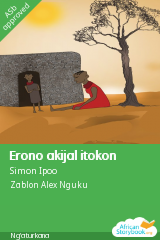African Storybook: Sitting on the dry sand with children in Turkana: Dr John Ng’asike’s experience
Dr John Ng’asike
African Storybook values community champions who understand the literacy needs of their communities and who do everything to create awareness among relevant stakeholders. These champions keep reminding us that every child from every community matters; that their literacy needs matter; and that we must always be aware of which children might be continuing to fall through the cracks even as large nationwide literacy programs are implemented. We share Dr. John Ng’asike’s African Storybook experience as he works with two primary schools in Turkana County, Kenya reading locally created Ng’aturkana storybooks with children.
The Kakwanyang Story
Kakwanyang Primary School is a rural public school in Turkana County with an enrollment of 137 pupils. Although performance in all subjects is below average, performance in languages is lower than the rest of the subjects. The only hope in Kakwanyang lies in intensified reading outside of formal time-table activities. But it has been difficult to convince teachers to offer close support to children’s mother tongue reading within the teaching program. The challenge is fear to teach a subject (mother tongue) perceived to be non-examinable. In addition, the teacher in charge of grades one and two is a non-Turkana, who reasons that he can do better teaching Kiswahili than mother tongue which he does not understand.
I took the initiative to engage children in mother tongue as a way of saying that every language is important and should be spoken. I got a rude shock as children just stared at me without a response. The children were very afraid to speak with me openly in their mother tongue before their teachers. The children cannot speak ‘Ng’aturkana’ before their teachers. But outside of school children engage with me in their mother tongue in the most creative ways.
But I persisted. In each of my visits to the school, I read a story in Ng’aturkana to a group of 15 to 20 children usually a combination of grades (1-5). Interestingly, even the older children are slow readers and they need to learn how to read. Children of Kakwanyang are not fluent readers at the age of ten when you expect children to be imaginative and fast readers. We read the story, very slowly, stressing each sentence as the reading continues. I am role modeling as children follow my reading. In the middle, I stop and ask a question to test their comprehension. After I finish I ask one child to read, and the rest follow the story. The most interesting part is when I ask the child to say the story in his/her own words. When children say the story in their own words, the story is shortened but overall sounds complete. Newer vocabularies are introduced in the story; the words are new and usually very authentic but very well fitting in the story. It is fun when children repeat the story. Sometimes a child will stray a little, stimulating laughter and a lot of feedback, correction and criticism from classmates. Every time a story is read with children it expands children’s vocabulary.
I read story entitled Erono akijal itokon (Danger of abandoning mother). In this story, children came up with words such as ASAPANET (meaning age mates). Another word is ALOGITA (hunting). The level of understanding of the deep meaning of words in a cultural context enables children to reason at the zone of proximal development, where their reasoning is higher than expected.
I stressed to the teachers that reading a story book in Ng’aturkana, requires practice….practice….practice and practice. Reading must begin early in the formative years of the child’s life.
Locher Esekon Early Childhood Development Center
When I visited this Centre early in May, the enrolment had dropped to 29 children (20 girls and 9 boys). Teachers explained that children are being withdrawn to help in house chores to support the family in herding livestock. The Primary school section has very new classrooms built through the Constituency Development Fund (CDF). Grades 1 and 2 learn under the trees with the help of a volunteer teacher. Enrolment remains a challenge as parents stay home with children. One cannot tell whether children are away because of they are expected to look after livestock or if it is for other reasons.
The children in the ECDE center use the tree shade as their classroom. Sitting on the sand is fun for Turkana children. Sand is the playing ground for little children and even adults. Therefore, to sit on the sand and enjoy a story is natural and authentic for Turkana pastoralist nomadic children. Usually the teacher sits on the yellow chair seen in the picture when teaching these early childhood children. However, when I sat on the sand, the teacher also sat on the sand. If she were to sit like this during most of her classes, she would act as a true traditional / cultural woman who can inspire children as they will easily identify with her since this is the way women in Turkana culture sit when interacting with children during story time.
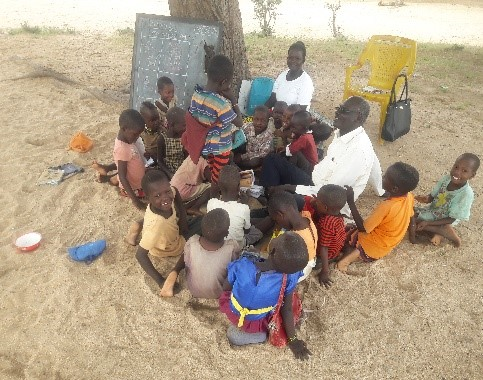
Dr. John Ng’asike reading a story with children |
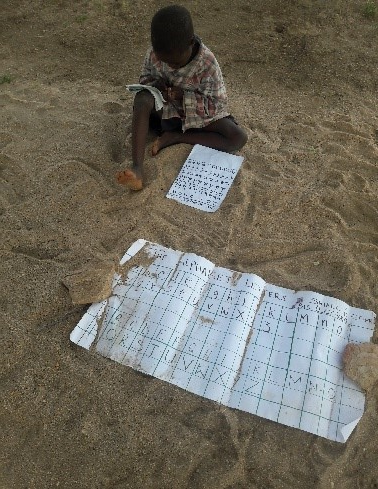
|
I read another story with the children entitled Muurui (Mysterious baby) with children. This is a story about a mysterious child. Muurui means mystery. I did not expect preschool children to be so attentive. I discovered that the children followed the story when I asked one of them to retell the story. At the beginning of the story, children were a little less close to me. As the story progressed, the children moved closer and we became one small unit. Children felt close to their father, a relative, an elder, an expert teacher. They enjoyed the warmth of the elder as I also enjoyed their childhood warmth. We could make fun of the words in the story which enriched learning beyond the story to understanding the depth of our cultural lifestyles.
Stories read to young children especially in early childhood basically serve the purpose of creating mental awareness. This is the time to prepare young children to begin to conceptualize the meaning of reading and the motivation to start to learn to read.
As a way forward I planned to set up a process of accounting the work of the children. For example, I must be able to tell the number of story books each child has read within some time frame. I need to be able to at least qualitatively measure how much the child has gained in terms of reading fluency in Ng’aturkana, Kiswahili and English. I have opened up a record book for each child so that I can track the number of stories each child is reading and when possible plan for strategies to reward the best reader.
I have also planned to meet community elders and local leaders (chiefs) and political leaders to ensure communities are involved in school activities and are encouraged to participate in the development of local stories. The ECDE teacher has identified two elderly women whom I will meet in my next visit to Locher Esekon to record stories from them. The process of collecting stories is ongoing. More engagement with teachers is critical. Teachers require mentoring. The perception that only Turkana Teachers can teach Ng’aturkana is misplaced. The teacher with the willingness to learn different cultures and who appreciates the importance of home language in literacy development can interact with children in different liguistic environments with less difficulties.
Generally teachers are resisting mother tongue instruction in the project area. Having teachers who are committed to mother tongue development is a need to explore.
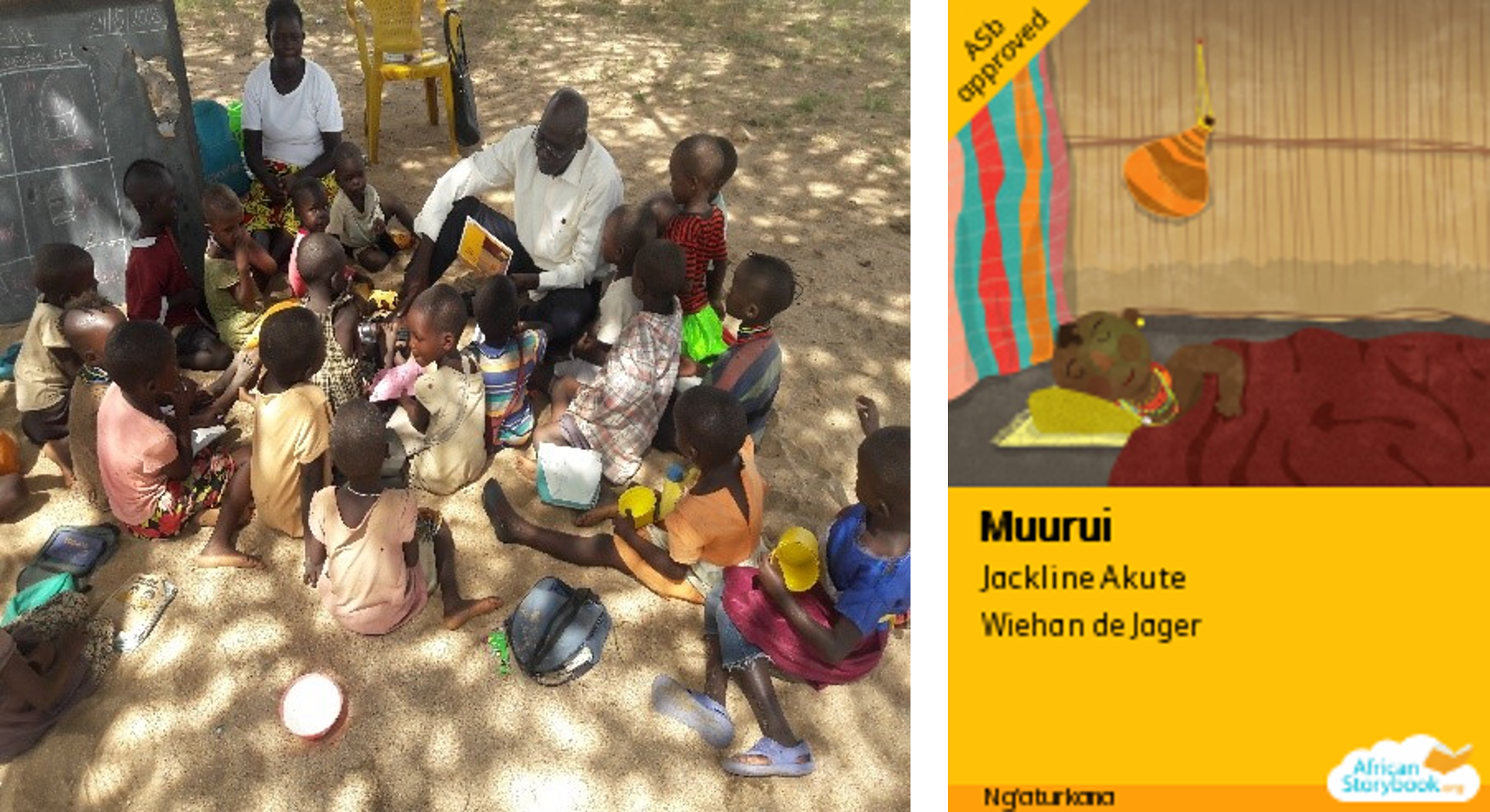
|
Finally, Saide has donated a computer loaded with 60 stories as well as a projector to project stories on the wall for childrn to read together. This is a good strategy to stimulate reading using technology. Kakwanyang has solar power and so it was easy to test this. The computer and power project will be used in rotation between Kakwanyang and Locher Esekon. Both schools have solar power. I will monitor on how this strategy will work to enhance reading. After reading using the computer, children will then be provided with reading books to continue reading at home as a follow up activity.
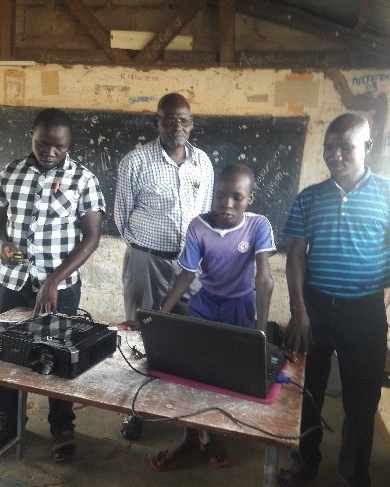
|
Conclusion
What teachers probably do not know is that educating children is an interaction that focuses on building relationships among people. Teachers assume the presence of children without serious consideration of their inner feelings and the human spirit that require connection with fellow human beings. Children need genuine relationships. They need to feel adult warmth and authentic interactions. For example, reading a story for the sake of covering the syllabus is not educating. Learning takes place when authentic relationships occur between learners and teachers. The appreciation that as human beings we all carry aspirations which we share as we engage each other in genuine relationships.
